Order EMBIOPTERA
(embios=lively)
(Web-spinners)
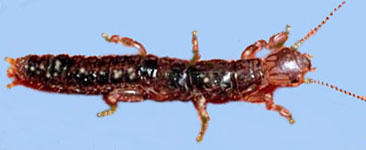
They are small slender-bodied insects, with a large prognathous head. Compound eyes are large in male but smaller in female. Ocelli are absent. Antennae are filiform and mouth parts mandibulate. Females are wingless and males winged, with membranous, transparent or sometimes cloudy equal-sized wings. Legs short, adapted for crawling. Fore leg with first segment of tarsus enlarged containing silk-gland. Thorax elongated, almost equal to abdomen. Cerci 2-segmented, asymmetrical in male.
They are gregarious insects, which live under bark, in rocks or in debris, in silken tunnels. Basically nocturnal and entirely phytophagous, feeding mostly on fungus. They are collected by aspirator or forceps and pinned through thorax.
Order DERMAPTERA
(derma=skin; pteron=wing)
(Earwigs)

This order contains 1100 species. The insects have narrow, elongated bodies with prognathous head and generally dark coloration. They have prognathous head, with well-developed compound eyes (sometimes absent). Ocelli absent. Antennae are long and filiform and mouthparts strong mandibulate. Forewings are reduced to short leathery tegmina under which large membranous, fan-like hind wings are kept folded like handkerchief. Before flying they take considerable time to unfold the hind wings with the help of forceps. Legs strong for walking and tarsi are 3-segmented. Abdomen is 11-segmented, at the tip of which cerci are modified in the form of forceps, which are used for defence. Ovipositor is reduced.
They are nocturnal and prefer moist dark places, sometimes attracted to light in the night. They are predaceous in tropics and herbivores in temperate areas. They can be collected with aspirator or can be picked by forceps, or by putting inverted killing bottle over them. They hide under the leaf sheaths, in flowers or under bark and can be obtained by sweeping through foliage and flowers. They can be pinned or preserved in alcohol.
Order PSOCOPTERA
(=CORRODENTIA)
(The name refers to genus Psocus and its chewing and corroding habits)
(Book lice)
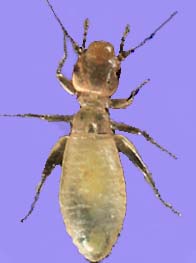
They are small, fragile, light-coloured wingless insects with large hypognathous head and depressed body. They have large compound eyes and 3 ocelli. Antennae are long and filiform. Mouth parts are manbibulate, used for feeding on debris, book-glue or cereals. Book lice are wingless but bark lice are winged, having membranous wings, fore wing being larger than hind wings. Wings are held tent-like over the abdomen while at rest. Legs are slim, hind femora are enlarged and tarsal segments are1-3 segmented. Abdomen is 10-segmented and cerci absent. Adults can make ticking sound by striking venter against the loose wood or paper. That is why sometimes they are called “death watch”. Psocopterans lay very large egg which measures about one-third of their body size.
Winged psocopterans can be collected by sweeping on the bushes or by beating over a white sheet and by the use of aspirator. Book lice can be collected from old books by using a wet brush dipped in alcohol.
Order MALLOPHAGA
(mallos=wool; phaga=to eat)
(Bird lice)
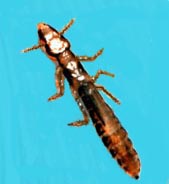
Bird lice are very common on birds and can be collected from their feathers by using wet alcohol dipped brush. They should be preserved in 70% alcohol and mounted on slide in Canada balsam.
This order contains 2000 species, which are ectoparasitic on birds, some on mammals. They possess dorsoventrally flattened body with a tough integument. Head is large and distinct, with short filiform antennae and strong biting and chewing mouthparts. Compound eyes reduced and ocelli absent. Legs are short and adapted for clinging; tarsi 1-2 segmented, claws two and curved. Abdominal segments 8-10 and cerci absent. Eggs are glued to the feather base. There are 3 nymphal instars. They feed on feathers, hairs, skin, scales and on dried blood around wounds.
Order ANOPLEURA
(=SIPHUNCULATA)
(anoplos=unarmed; uros=tail)
(Sucking lice, human body and head lice)

There are 400 species in this order, which are all ectoparasites of mammals. They are small grey or pale insects with dorso-ventrally flattened bodies, with small head. Eyes are rudimentary and ocelli absent. Antennae 3-5 segmented and filiform. Mouthparts are modifies for sucking. Legs are short and stout and joined on the side of the thorax. Tarsi 1-segmented. Claw single, long, curved and adapted for clinging on to the hair. They are secondarily wingless. Abdomen 9-segmented and contains no cerci. They live on mammals at constant body temperatures and transmit diseases such as relapsing fever, epidemic typhus and trench fever.
They can be collected from the hosts by using alcohol-dipped brush and preserved in alcohol and mounted on slide.
Order THYSANOPTERA
(thysanos=fringe; pteron=wing)
(Thrips)
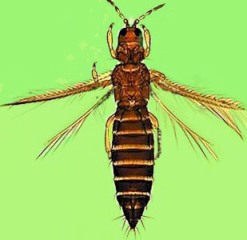
This order contains about 2500 species which are commonly known as thrips. They have long narrow wings, whose margins are fringed with long hairs. head hypognathous with prominent compound eyes and short antennae containing 6-10 segments.
Mouthparts are rasping and sucking type. Legs short, with one or two tarsal segments and claws reduced but arolium enlarged. Cerci are absent. Thrips live in a variety of habitats, viz. in cracks and crevices, under leaf sheaths or in flower petals or in grasses. Some species are aquatic. Most of the species feed on plant tissues by rasping the epidermis and therefore pests of agriculture, some are scavengers and others predators of small insects such as aphids and mites. They lay eggs inside the plant tissues. Some species serve as vectors of bacterial and viral plant diseases.
They can be collected by beating the foliages or flowers over the beating tray. Also can be collected by sweeping through the foliage. As they are quick moving insects, they should be collected by aspirator and preserved in alcohol and mounted on slide.
Order HEMIPTERA
(hemi=half; pteron=wing)
(Bugs, cicadas, leafhoppers, aphids, water striders, scale insects, whiteflies, assassin bugs)
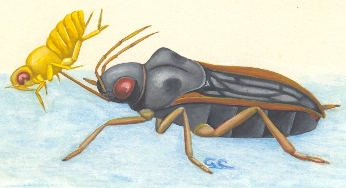
This is a large order containing small to large insects, which occur in highly varied habitats. Compound eyes are large and ocelli may be present or absent. Antennae 2-10 segmented, filiform or aristate. Mouthparts are piercing and sucking type segmented proboscis. There is a large, triangular scutellum on thorax. Cerci are absent.
In Heteroptera, fore wing is half thick, parchment like and hind wing is membranous, while in Homoptera both wings are membranous. Most of them are plant sucking insects and therefore noxious pests of agriculture, some are predators of pests (assassin bugs) and therefore useful to farmers, some are blood sucking parasites, such as bed bugs. They are also vectors of animal and plant diseases.
They can be collected by employing a variety of methods because of their highly variable size and habitat. Aquatic species can be collected with water nets and cicadas can be shot with dust-guns. Large species are pinned through scutellum and viscera removed by slitting the abdomen. Small specimens should be preserved in alcohol and mounted on slide
Order GRYLLOBLATTODEA
(Ex. Grylloblatta)
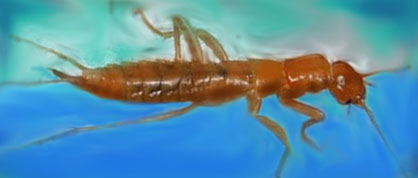
Only six species, which show primitive features, are known from North America, Russia and Japan. The insects are found beneath stones, up to an altitude of 6,000 feet. They are related to Orthoptera from which they must have separated very early in evolution.
They are wingless insects, without eyes and ocelli but sometimes reduced eyes are present. Antennae are long and filiform and mouthparts mandibulate. All legs are similar and for slow-walking with 5-segmented tarsi. There is one pair of long, 8-segmented, filiform cerci. Female possesses long ovipositor. Head is prognathous and body dorsoventrally flattened.